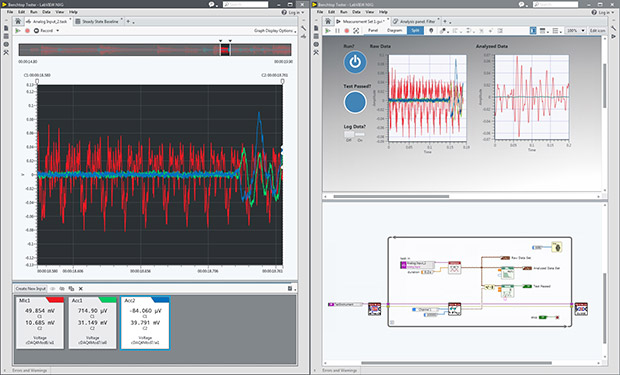
An example of a professional-level engineering instrumentation system created in LabVIEW NXG 1.0. Image courtesy of National Instruments.
Latest News
June 14, 2017
At the recent NI Week conference, NI (National Instruments) announced the first release of its next generation of LabVIEW and the 2017 edition of its LabVIEW engineering system design software for test, measurement and control applications. The new LabVIEW NXG 1.0, the company says, “bridges the gap between configuration-based software and custom programming languages with an innovative new approach to measurement automation that empowers domain experts to focus on what matters most—the problem, not the tool.”
 Version 1.0 of the LabVIEW NXG software for test, measurement and control system design provides engineers with streamlined workflows for acquiring, analyzing and exporting measurement data without programming. Image courtesy of National Instruments.
Version 1.0 of the LabVIEW NXG software for test, measurement and control system design provides engineers with streamlined workflows for acquiring, analyzing and exporting measurement data without programming. Image courtesy of National Instruments.LabVIEW NXG 1.0 provides engineers as well as non-programming technical professionals performing measurements with data acquisition devices and benchtop instruments a streamlined, “no programming required” workflow that minimizes the time to measurement for acquiring and visualizing data sets. LabVIEW NXG offers users the option to use a development approach to customize a test and measurement system if needed.
LabVIEW NXG’s non-programming workflows simplify automation by building the necessary code behind the scenes, which can help engineers focus on innovation rather than implementation, explains NI. By way of example, NI reports that engineers using LabVIEW NXG can drag and drop a section of code equivalent to 50 lines of text-based code.
 LabVIEW NXG 1.0 provides users with such features as auto-discovery and interactive panels that can speed time to measurement. Image courtesy of National Instruments.
LabVIEW NXG 1.0 provides users with such features as auto-discovery and interactive panels that can speed time to measurement. Image courtesy of National Instruments. Version 1.0 of the LabVIEW NXG software for test, measurement and control system design provides engineers with streamlined workflows for acquiring, analyzing and exporting measurement data without programming. Image courtesy of National Instruments.
Version 1.0 of the LabVIEW NXG software for test, measurement and control system design provides engineers with streamlined workflows for acquiring, analyzing and exporting measurement data without programming. Image courtesy of National Instruments.NI reports that LabVIEW NXG introduces a re-engineered editor with functionality that experienced LabVIEW users often request, but it still offers a user experience similar to complementary software in the market. The refreshed editor further extends the openness of LabVIEW to integrate with a broader set of languages. The modernized editor improves programming productivity by streamlining the editor micro-interactions, user interface objects based on vector graphics and zooming capabilities.
Version 1.0 of LabVIEW NXG provides a subset of features and hardware support currently in LabVIEW 2017, says NI. Standard features include a native graphical programming interface; the ability to view signals and configure hardware with the measurement panel; the ability to execute multithreaded code; and the ability to analyze data sets and visually adjust parameters with interactive panels.
 An example of a professional-level engineering instrumentation system created in LabVIEW NXG 1.0. Image courtesy of National Instruments.
An example of a professional-level engineering instrumentation system created in LabVIEW NXG 1.0. Image courtesy of National Instruments.Among the hardware compatibility features shared with LabVIEW 20017 are NI and third-party hardware auto-discovery and driver install; support for many of NI’s hardware platforms, such as PXI digital I/O modules; and support for such instruments as digital multimeters and waveform generators. LabVIEW NXG and LabVIEW 2017 software compatibility features include texture/color editing of UI (user interface) control appearance and support for the LabVIEW MathScript RT module. Additional support for other NI modules and toolkits is planned.
New capabilities making their debut in LabVIEW 2017 target the development, deployment and management of large, complex and distributed test and embedded applications. These include features that enhance interoperability with standard IP and standard communications protocols such as IEC 61131-3, OPC UA and the secure DDS messaging standard.
 This LabVIEW NXG screen capture depicts a module for vibration signal conditioning. Image courtesy of National Instruments.
This LabVIEW NXG screen capture depicts a module for vibration signal conditioning. Image courtesy of National Instruments.“Thirty years ago, we released the original version of LabVIEW, designed to help engineers automate their measurement systems without having to learn the esoterica of traditional programming languages,” said Jeff Kodosky, NI co-founder and business and technology fellow, in a press statement. “LabVIEW was the ‘non-programming’ way to automate a measurement system.”
“For a long time we focused on making additional things possible with LabVIEW, rather than furthering the goal of helping engineers automate measurements quickly and easily,” Kodosky continued. “Now we are squarely addressing this with the introduction of LabVIEW NXG, which we designed from the ground up to embrace a streamlined workflow. Common applications can use a simple configuration-based approach, while more complex applications can use the full open-ended graphical programming capability of the LabVIEW language.”
For more information on LabVIEW NXG 1.0, click here.
Watch “Using LabVIEW Without Programming.”
Compare LabVIEW NXG 1.0 and LabVIEW 2017.
To learn more about LabVIEW 2017 start here.
Check out NI’s roadmap for LabVIEW NXG.
Read DE’s coverage of LabVIEW NXG and the NI Week conference here.
See why DE‘s Editors selected NI’s LabVIEW NXG 1.0 as their Pick of the Week.
Sources: Press materials received from the company and additional information gleaned from the company’s website.
Subscribe to our FREE magazine, FREE email newsletters or both!
Latest News
About the Author
Anthony J. Lockwood is Digital Engineering’s founding editor. He is now retired. Contact him via [email protected].
Follow DE




